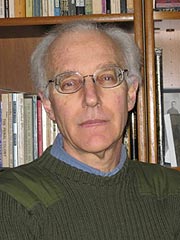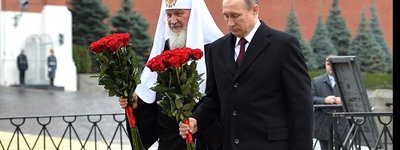Inculturation

 In September, during his first official visit to the United States, the newly elected head of the Ukrainian Greek Catholic Church, Major Archbishop Sviatoslav (Shevchuk), gave an interview to the Ukrainian diaspora newspaper “Svoboda,” published in English translation by the “Ukrainian Weekly” (2 October 2011, pp. 1, 10-11). Among his chief themes was that of “inculturation,” which he connected with the Church’s task of a “new evangelization.” He posed the issue as one of how to introduce Eastern Catholicism into a culture like that of Argentina, where he studied and later served as apostolic administrator (2010-2011).
In September, during his first official visit to the United States, the newly elected head of the Ukrainian Greek Catholic Church, Major Archbishop Sviatoslav (Shevchuk), gave an interview to the Ukrainian diaspora newspaper “Svoboda,” published in English translation by the “Ukrainian Weekly” (2 October 2011, pp. 1, 10-11). Among his chief themes was that of “inculturation,” which he connected with the Church’s task of a “new evangelization.” He posed the issue as one of how to introduce Eastern Catholicism into a culture like that of Argentina, where he studied and later served as apostolic administrator (2010-2011).
Inculturation is the process by which a religion, entering a particular culture, takes on some of its features while infusing it with its message. The process is necessary in order to make that message comprehensible to that culture. Thus, for example, the teaching of Christ was inculturated in Greco-Roman culture, borrowing Greek philosophical concepts in order to formulate and explain its tenets, and using the Latin language to communicate them throughout the Empire. Several centuries later, Christianity became inculturated among the Slavs – first by Saints Cyril and Methodius and their followers, who developed an alphabet and a language by which Christian sacred texts could be translated and communicated to the Slavs. These were accompanied by a new Slavonic Christian culture elaborated in Bulgaria. This culture was then transplanted to Kyivan Rus’, where Christianity was further inculturated among the princely families and their East Slavic subjects. The result was the Byzantine-Kyivan church culture of today’s Catholic and Orthodox churches of Ukraine and neighboring countries, including that of Major Archbishop Sviatoslav’s Ukrainian Greek-Catholic Church.
The question confronting Vladyka Sviatoslav, however, is how today’s Ukrainian Christianity can become inculturated in places like Argentina, Canada, or the United States. A preliminary question that must be answered, however, is what exactly is the cultural identity of his Church. It is, to be sure, Byzantine-Kyivan. But over the centuries since its re-union with Rome at the 1596 Union of Brest, it has experienced periods of latinization. The Synod of Zamosc of 1720, for example, introduced a number of Latin practices into the Byzantine-Kyivan rite. Latin customs like May Marian devotions, the cult of the Sacred Heart of Jesus, and kneeling for communion have been assimilated by the Greek-Catholics in many places. This can be seen as a continuing “inculturation” into the dominant Polish and Roman Catholic society in which Greek-Catholics lived until 1939. In the 1860s, however, determined attempts were made to de-latinize the Greek-Catholic rite, drawing on Orthodox models. Which features should be retained today, and which ones rejected? Greek-Catholic parishes in Ukraine follow the Julian calendar; all but a few in America follow the Gregorian. Where in time does the Church find itself? In short, there is disagreement on what exactly constitutes Ukrainian Greek-Catholic church culture.
And yet, that as yet undefined culture must now be further “inculturated” in the various countries where Ukrainian Greek-Catholics live. Even in their homeland, this means that it must partake, to some extent, of post-Soviet culture, which is torn between Russian and Soviet influences on the one hand, and Western ones on the other. In the diaspora, the situation is even more complex, for there one can speak of four cultures: that of the Church itself, that of the Ukrainian diaspora, the general culture of the host country, and the host country’s own religious culture (in the case of Argentina, Latin American Catholicism; in the case of North America, a Protestant or post-Protestant culture). To complicate matters further, while religious cultures tend to evolve gradually, the broader cultures in both Ukraine and the lands of the emigration are experiencing rapid change.
Inculturation is not an automatic process. It must be negotiated consciously and carefully. Church leaders must decide which features of the surrounding culture should be accepted, which should be rejected, which should be challenged or discussed. Early Christians drew on the concepts of Socrates, Plato and Aristotle, but must have considered other Greek and Roman philosophers with skepticism. While in early Christian Rus’ the worship of wood or stone idols was eliminated, many features of pagan folk religion like spring fertility rites, midsummer and midwinter celebrations, and fall harvest customs could be Christianized, and thus remain to this day. Similarly, Greek-Catholics in Ukraine may share in many traditions of the Orthodox majority, while rejecting the crass materialism of post-Soviet oligarchal culture. They may endorse European freedom and democracy, but not European secularism.
In the same way, Ukrainian Catholics in the diaspora may keep a respectful distance from the ways of American evangelicals, Canadian Presbyterians, or Argentine Roman Catholics. They will of course participate in the broader Ukrainian diaspora culture, but not without a critical eye. They may emulate American pluralism and democracy, but not American materialism. Today, Ukrainian Catholics are emigrating to a wide variety of countries. How will they engage the culture of a society where bribery is considered normal, where marriage and the family are fighting a losing battle, where the state sanctions the killing of innocents, or where unbelief is considered a sign of education?
Vladyka Sviatoslav has linked inculturation with the “new evangelization.” Historically, this has meant determining the attitude of the Christian Church to the cultures of mission territories. When the Jesuits entered China in the seventeenth century, for example, the question arose whether converts would have to abandon their own culture, which included rituals honoring ancestors and the philosopher Confucius. The Jesuits believed that one could accommodate these rites to the Catholic faith, while the mendicant orders disagreed. Papal decrees of 1715 and 1742 banned the Chinese rites and ended the discussion. However, the controversy has continued, and remains an interesting study in the question of inculturation. In 1939, in an apparent reversal, Rome ruled that East Asian converts to Catholicism in Japanese-occupied Manchukuo could practice compulsory Shinto rites. In China today, many Catholics harmonize their faith with Chinese tradition. (D.E. Mungello, “The Significance of the Chinese Rites Controversy in Sino-Western History – An Introduction,” San Francisco, 1992).
But the “new evangelization” must deal not only with ancient local cultures, but also with contemporary global culture. Which of its aspects are compatible with Christianity? How can the Christian message be rendered comprehensible and acceptable without compromising its integrity? Each Church of the Catholic communion will have to confront this question over and over again. For Christianization is not a one-time event, but a continuing process that must be repeated with each generation. Thus, the inculturation of Christianity can never be achieved in one fell swoop. It is a constant negotiation and re-negotiation with the surrounding and ever-changing culture and sub-cultures. Vladyka Sviatoslav has launched his Church on a challenging and fascinating adventure.










